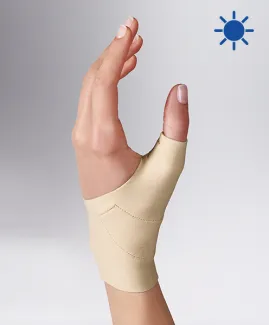
Treatments for arthritis of the thumb are different according to the stage of the condition. Indeed, it causes pain at the base of the thumb and progressively impairs the function of the hand, or causes the deformity of the thumb.
To stop the process and have pain relief, many treatments for arthritic thumbs exist like thumb support braces, exercises, drugs and surgery. Find out how to treat arthritis in the thumb joint according to the European League Against Rheumatism(1, 2, 3).
How to treat arthritis in the thumb joint in mild to moderate cases
The treatment for thumb arthritis must be adapted to the severity of the condition. Firstly, it is recommended to opt for ergonomic tools and to do some exercises that improve muscle function and reduce tenderness at the base of your thumb.
Exercises for thumb basal joint arthritis
Doing some exercises is part of the treatment for arthritic thumbs. It helps to preserve and improve the mobility and stability of your joint at the base of your thumb as well as muscle strength. It consequently helps to ease your pain(2).
They are mainly strengthening exercises and range of motion exercises(1). Those exercises should be specific according to the stage of your condition. For that reason, ask for some pieces of advice from your doctor or physical therapist.
Braces and splints in the treatment for arthritis of the thumb
Wearing a brace for resting periods that immobilises the painful joint in the long term is particularly appropriate. EPITACT® has created a night thumb brace* that keeps the thumb in a neutral position.
The brand has also developed a new kind of orthopaedics, which can be used as a complement to rigid braces and splints for the thumb. This innovative thumb support* is totally flexible and has a specific design and fabric that makes you aware of daily traumatic movements so that you can intuitively correct them. By limiting those movements, it reduces the stress to your joint while you can continue your daily activities.
It is essential for you to understand the impact of such a condition on daily life. It is also important that you know all the treatments for arthritis in the thumb that can protect your joints. It is necessary that health professionals provide support devices to help in daily life, such as braces created to immobilise the trapeziometacarpal joint.
Thumb arthritis: treatment with medicines
Drug therapy is required if the previous treatments for arthritic thumbs were not effective enough.
Oral medication
When pain is too intense, topical NSAIDs (non-steroidal anti-inflammatory drugs) in cream or gel form are preferred compared with oral analgesics. Punctual use of paracetamol to be taken orally and then anti-inflammatory medication, if necessary, can relieve symptoms.
Chondroitin sulfate can be used to relieve pain in the short term and to improve joint function. It would slightly reduce arthritis attacks.
Self-medication should be banned: only a health professional can suggest the appropriate treatment option for arthritic thumbs.
Injections
Corticosteroids or hyaluronic acid can also be suggested for the treatment of thumb arthritis. Some studies show that hyaluronic acid is less efficient in the short term (< 6 weeks) than corticosteroids, but more efficient in the long term (after 6 months). Injections would be more efficient on pain than on grip strength or joint mobility. Recent studies indicate that corticosteroid injections in the joints shouldn’t be used in patients suffering from hand arthritis but can be prescribed for patients with painful interphalangeal joints.
Lastly, thumb arthritis should not be treated with conventional or biological antirheumatic drugs, which may modify the condition.
Surgery for arthritis of the thumb: treatment of last resort
Surgery is only performed in patients with structural abnormalities or when other thumb arthritis treatments have been insufficient to reduce pain. For people with arthritis at the base of the thumb, trapeziectomy is the preferred technique. It involves removing the trapezium bone. However, arthrodesis (joint fusion) and arthroplasty (joint replacement) are more frequent in people with interphalangeal arthritis. For more details about the surgery, click here.
You have learnt how to treat arthritis in the thumb joint thanks to orthotics, drugs, exercises and surgery. However, be aware that this condition worsens over time if it is left untreated. So, see your general practitioner as soon as the first symptoms of thumb arthritis appear. He suggests the most appropriate treatment for your arthritic thumbs.
*These solutions are class I medical devices that bear the CE marking under this regulation. Carefully read the instructions before use. Manufacturer: Millet Innovation. 12/2021
For more details about this general and simplified approach, here are further sources:
(1)Zhang, W, M Doherty, B F Leeb, L Alekseeva, N K Arden, J W Bijlsma, F Dincer, et al. 05/2007 « EULAR Evidence Based Recommendations for the Management of Hand Osteoarthritis: Report of a Task Force of the EULAR Standing Committee for International Clinical Studies Including Therapeutics (ESCISIT) ». Annals of the Rheumatic Diseases 66 (3): 377 88.
(2)Kloppenburg, Margreet, Féline PB Kroon, Francisco J Blanco, Michael Doherty, Krysia S Dziedzic, Elsie Greibrokk, Ida K Haugen, et al. 05/2019 « 2018 Update of the EULAR Recommendations for the Management of Hand Osteoarthritis ». Annals of the Rheumatic Diseases 78 (1): 16 24
(3)Hochberg, Marc C., Roy D. Altman, Karine Toupin April, Maria Benkhalti, Gordon Guyatt, Jessie McGowan, Tanveer Towheed, Vivian Welch, George Wells, et Peter Tugwell. 05/2012 « American College of Rheumatology 2012 Recommendations for the Use of Nonpharmacologic and Pharmacologic Therapies in Osteoarthritis of the Hand, Hip, and Knee ». Arthritis Care & Research 64 (4): 465 74. 05/2012 110 15.
 Pharmacie
Pharmacie

